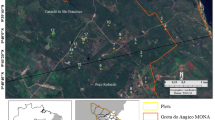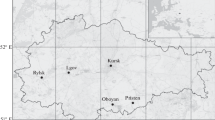Abstract
Restoration of disturbed ecosystems is an urgent scientific problem, the solution of which will allow preserving the biological diversity of Russian regions. During the restoration of steppe ecosystems on the territory of the Kulikovo field, various methods and approaches have been used over the past 20 years, which has made it possible to form agrosteppes of different ages. However, the diversity of their vegetation has not yet been assessed. The goal of this study was to identify the coenotic diversity of agrosteppes based on the ecological–phytocoenotic approach and to assess the directions of succession development of the selected associations. The authors carried out 96 geobotanical descriptions of the vegetation of agrosteppes, indicating the total projective cover for the grass layer and the projective cover (%) for each species. The ordination of descriptions was performed on the basis of a trendless DCA correspondence analysis using the PC-ORD program. To compare the identified associations, the indicator of species activity was determined. According to the results of the study, five associations of agrosteppe vegetation were identified. At the early stages of development of agrosteppes, communities of the Matricaria inodora + Artemisia absinthium association are formed, which are characterized by the dominance of taproot species. Densely tufted grasses grow in the communities of the Stipa spp. + Festuca valesiaca association. However, the low competitiveness of densely tufted grasses in the climate conditions of the northern forest–steppe contributes to the loss of fescue and its replacement by narrow-leaved bluegrass, which leads to the formation of the Stipa spp. + Poa angustifolia association. Wood reed is actively introduced into the communities of agrosteppes and increases its activity, which leads to the emergence of the Calamagrostis epigejos association. As agrosteppe communities develop, the activity of anthropogenic and some sown steppe species decreases, but an increase in the activity of meadow grasses in the selected associations is noted. This analysis indicates a low degree of preservation of “feather grass” associations and the formation of communities of steppe meadows.





Similar content being viewed by others
Notes
The Latin names of plant species are presented according to the study by S. K. Cherepanov (1995).
REFERENCES
Aleksandrovskii, A.L., Anthropogenic evolution of the Kulikovo field soils, in Antropogennaya transformatsiya pochv i ikh komponentov (Anthropogenic Transformation of Soils and Their Components), Moscow: Inst. Geol. Akad. Nauk SSSR, 1987, pp. 88–104.
Averinova, E.A., Meadow steppes and steppe dry meadows of the southeastern part of the Tula region, Problemy Izucheniya i Vosstanovleniya Landshaftov Lesostepnoi Zony, 2011, no. 2, pp. 40–47.
Bulokhov, A.D., Travyanaya rastitel’nost’ Yugo-Zapadnogo Nechernozem’ya Rossii (Herbaceous Vegetation of the Southwestern Non-Chernozem Region of Russia), Bryansk: Bryansk. Gos. Ped. Univ., 2001.
Bulokhov, A.D. and Solomeshch, A.I., Ekologo-floristicheskaya klassifikatsiya lesov Yuzhnogo Nechernozem’ya Rossii (Ecological and Floristic Classification of Forests of the Southern Non-Black Earth Region of Russia), Bryansk: Bryansk. Gos. Ped. Univ., 2003.
Burova, O.V., History of land use in the forest-step in Upper Don basin from the XII till XX century, Izv. Ross. Akad. Nauk, Ser. Geogr., 2005, no. 3, pp. 22–37.
Burova, O.V., The stages of development and anthropogenic transformation of forest-steppe landscapes in the Upper Don basin, Problemy Izucheniya i Vosstanovleniya Landshaftov Lesostepnoi Zony: Istoriko-Kul’turnye i Prirodnye Territorii, 2018, no. 4, pp. 7–11.
Cherepanov, S.K., Sosudistye rastenii Rossii i sopredel’nykh gosudarstv (Vascular Plants of Russia and Neighboring Countries), St. Petersburg: Mir i Sem’ya, 1995.
Chibilev, A.A., Levykin, S.V., Kochurov, B.I., and Kazachkov, G.V., Prospects of convergence of sciences for solving the problems of critical areas of the biosphere, Yug Rossii: Ekologiya, Razvitie, 2018, vol. 13, no. 4, pp. 129–138.
Danilov, V.I., Steppe vegetation of the Kulikovo field and problems of its restoration. Kulikovo field and the Battle of the Don in 1380, Trudy Gosudarstvennogo Istoricheskogo Muzeya, 2005, no. 150, pp. 257–298.
Danilov, V.I. and Burova, O.V., Experiments on the restoration of steppe vegetation on the Kulikovo field, Stepnoi Byulleten’, 2006, no. 20, pp. 34–37.
Dzybov, D.S., The method of accelerated reconstruction of herbaceous communities, in Eksperimental’naya biogeotsenologiya i agrotsenozy (Experimental Biogeocenology and Agrocenoses), Moscow: Nauka, 1979, pp. 129–131.
Dzybov, D.S., Osnovy biologicheskoi rekul’tivatsii narushennykh zemel’ (Fundamentals of Biological Reclamation of Disturbed Lands), Stavropol’: Agrus, 1995.
Dzybov, D.S., Metod agrostepei: Uskorennoe vosstanovlenie prirodnoi rastitel’nosti. Metodicheskoe posobie (Agrosteppe Method: Accelerated Restoration of Natural Vegetation. Methodological Guide), Saratov: Nauchnaya Kniga, 2001.
Glasko, M.P., Gol’eva, S.A., Sycheva, S.A., and Burova, O.V., Landscapes of the Battle of the Don: Return of the Lost, Trudy Gosudarstvennogo Istoricheskogo Muzeya, 2005, no. 150, pp. 227–256.
Golovina, E.O., Cirrus feather grass steppes of the southeast of the Tula oblast, Problemy Izucheniya i Vosstanovleniya Landshaftov Lesostepnoi Zony, 2011a, no. 2, pp. 53–58.
Golovina, E.O., Meadow steppes of the southeast of the Tula oblast, Vestn. Tverskogo Gos. Univ., Ser. Biol. Ekol., 2011b, no. 20, pp. 83–100.
Golovina, E.O., Steppe meadows on the slopes of the Smolka river valley (southeast of the Tula oblast), Problemy Izucheniya i Vosstanovleniya Landshaftov Lesostepnoi Zony: Istoriko-Kul’turnye i Prirodnye Territorii, 2013, no. 3, pp. 98–104.
Gonyanyi, M.I., Aleksandrovskii, A.L., and Glasko, M.P., Severnaya lesostep’ basseina Verkhnego dona vremeni Kulikovskoi bitvy: Gosudarstvennyi istoricheskii muzei (Northern Forest-Steppe of the Upper Don Basin During the Battle of Kulikovo), Moscow, 2007.
Hill, M.O. and Gauch, H.G., Detrended correspondence analysis: An improved ordination technique, Vegetatio, 1980, vol. 42, pp. 47–58.
Isachenko, T.I. and Lavrenko, E.M., Botanical and geographical zoning, in Rastitel’nost’ evropeiskoi chasti SSSR (Vegetation of the European Part of the USSR), Leningrad: Nauka, 1980, pp. 10–20.
Kurbatova, A.I., Analytical review of modern studies of changes in the biotic components of the carbon cycle, Vestnik Rossiiskogo Universiteta Druzhby Narodov. Seriya: Ekologiya i Bezopasnost’ Zhiznedeyatel’nosti, 2020, vol. 28, no. 4, pp. 428–438.
Kurganova, I.N., Emission and balance of carbon dioxide in terrestrial ecosystems of Russia, Doctoral (Biol.) Dissertation, Pushchino, 2010.
Malyshev, L.I., Floristic zoning based on quantitative traits, Bot. Zh., 1973, vol. 58, no. 11, pp. 1581–1602.
Rozova, I.V. and Volkova, E.M., The assessment of the land structure of Kulikovo field with using gis technologies, Izv. Tul’sk. Gos. Univ., Estestv. Nauki, 2020, no. 3, pp. 27–39.
Tishkov, A.A., Ecological restoration of the transformated steppe ecosystems, Voprosy Stepevedeniya, 2000, vol. 2, pp. 47–61.
Tishkov, A.A., Preservation of the grassland biodiversity in the Russian agrolandscapes, in Ustoichivoe razvitie sel’skogo khozyaistva i sel’skikh territorii. Zarubezhnyi opyti problemy Rossii (Sustainable Development of Agriculture and Rural Areas. Foreign Experience and Problems of Russia), Moscow: KMK, 2005, pp. 335–356.
Tishkov, A.A., Biosphere functions and ecosystem services of landscapes within the steppe zone of Russia, Aridnye Ekosistemy, 2010, vol. 16, no. 1 (41), pp. 5–15.
Titlyanova, A.A., Biologicheskii krugovorot ugleroda v travyanykh biogeotsenozakh (Biological Carbon Cycle in Grass Biogeocenoses), Novosibirsk: Nauka, 1977.
Vasilevich, V.I., Dominant-floristic approach to the identification of plant associations, Bot. Zh., 1995, vol. 80, no. 6, pp. 28–39.
Volkova, E.M., Polyancheva, S.A., Rozova, I.V., and Burova, O.V., The experimental restoration of steppe vegetation of Kulikovo Field (Tula Oblast): Some results of the cenotic diversity assessment, Izv. Tul’sk. Gos. Univ., Estestv. Nauki, 2020, no. 4, pp. 49–64.
Volkova, E.M., Lebedeva, M.V., and Yamalov, S.M., Vegetation dynamics of Kulikovo Field agrosteppes: The contribution of environmental factors, in Ninth International Symposium “Steppes of Northern Eurasia”. IOP Conference. Series: Earth and Environmental Science, 2021, no. 817, p. 012112.
Volkova, E.M., Burova, O.V., and Rozova, I.V., Vosstanovlenie stepnoi rastitel’nosti Kulikova polya (metody i rezul’taty eksperimentov (Restoration of the Steppe Vegetation in the Kulikovo Field (Methods and Experiment Results)), Tula: Tul’sk. Gos. Univ., 2022.
Funding
The work was supported by the RFBR grant 19-44-710 001 (Vegetation cover of the Kulikovo field and its dynamics under the influence of natural and anthropogenic factors as a basis for developing approaches to preserve and restore the landscape and biological diversity of the forest–steppe regions of European Russia), the agreement with the government of the Tula oblast DS/305 and the grant of the rector of TulSU for students in educational programs of higher education, master’s programs, No. 8945 GRR_M (Agrosteppes of the Kulikovo field and their role in carbon sequestration as the basis for creating a carbon landfill in the Tula oblast).
Author information
Authors and Affiliations
Corresponding author
Ethics declarations
Conflict of interests. The authors declare that they have no conflicts of interest.
Additional information
Translated by L. A. Solovyova
Rights and permissions
About this article
Cite this article
Volkova, E.M., Polyancheva, S.A. & Rozova, I.V. The Vegetation and Dynamics of Agrosteppes in the European Part of Russia (Tula Region, Kulikovo Field). Arid Ecosyst 13, 403–411 (2023). https://doi.org/10.1134/S2079096123040194
Received:
Revised:
Accepted:
Published:
Issue Date:
DOI: https://doi.org/10.1134/S2079096123040194




